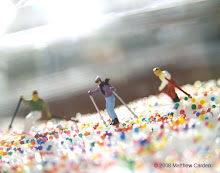THE LITTLE DIPPER
SEEDS TO STARS
BY JENNIFER CARDEN
Feeding the birds is a nice thing to do, but feeding your
kids can be even more fun!

If you missed the new Spring issue of Edible Marin Wine Country you can still read my article right here.
Do you remember when you were in grade school
and you made pine cone feeders for the birds?
Picture this—the teacher gave out a paper plate
with a bit of peanut butter that you spread onto a pine cone
and then rolled the whole thing in birdseed. IF it made it
home in one piece, you hung it up in a tree, and, if you were
lucky, the birds came to enjoy it and you got to watch them
feed at your very own creation.
For some, seeds are strictly “for the birds.” I have noted that
this is particularly true for children. Getting kids excited
about any food can be a real challenge, but texture seems to
be a particularly important component in whether a child
will embrace a new food. Kids can be picky about certain
things like large pieces of tomato or onion in sauce, and
nothing can be too gritty, too slimy, or too green—just to
mention a few. Seeds definitely fall into this texture category:
seeds in their bread, on bagels, in rice or in trail mix.
But, it is spring and a time for renewal and attention to
healthy eating. The seed family, which includes nuts, beans
and grains, contains fiber and essential fatty acids which are
vitally important to growing bodies and, especially, brains. In
addition, they can add great dimension and flavor to foods.
To make sure your child is getting his or her seeds, and
liking them too, try making this yummy protein powder to
have on hand to sprinkle over a variety of different foods—
we think it is exceptionally delicious sprinkled on a sliced
banana, drizzled with honey and served with thick Greek
yogurt. They should too!
SEED PROTEIN POWDER:
1 Tbsp. Flax seeds
2 Tbsp. Sesame seeds
2 Tbsp. Sunflower seeds
Grind all three seeds together in a coffee grinder or blender.
May be stored in the refrigerator for up to one month.

The most nutritious seeds in the world:
Flax Seeds
The protein in flax seeds is easily digested and contains all
the amino acids needed for building a strong body.
Sunflower Seeds
These little gems are packed with nutrients. In fact, they are
considered by many to be the most perfect in nutrients, supplying
all the body’s needs except vitamin D, which can be
easily obtained by standing in the sun. Birds at a feeder will
pick through all the other seeds to get to the prized sunflower
seed. Birds are smart!
Pumpkin Seeds
Pumpkin seed oil contains omega 3 and omega 6 fatty acids
making them highly nutritious. Pumpkin seeds are also a
great source of vitamin A, calcium and iron.
Sesame Seeds
Sesame seeds contain 19% protein, compared with 13% in
eggs. They are also an excellent source of B vitamins and
other minerals.
Because seeds contain such a large amount of oil, they can go
rancid fairly quickly. Their shelf-life will be extended by roasting
them in the oven or toasting them on the stove top. This will also
change their flavor, however. Additionally, raw is the most healthful
way to eat seeds (and most nuts) because the essential oils in
them may be damaged by the heat. You can tell if seeds are rancid
because they will have an acrid or “off” odor. Try a taste test with
your kids, raw vs. toasted, to see which they like better.
Lil' Dipper
Be a Star and Connect the Dots.
This is a fun way to learn about the stars and eat healthy
at the same time. If you have a peanut allergy or would
just like to try something new, use sunflower butter or
another alternative butter.
YOU WILL NEED:
• A plate with a rim
• Zip top bag
• 1/4 cup peanut butter or sunflower butter, at room
temperature
• 1/2 cup assorted unshelled seeds (sunflower, flax, sesame,
and/or pumpkin)
• Celery or carrot sticks and crackers
Fill the bag with the nut butter, seal and squish down to
one corner. Snip a very small tip off one corner of the bag.
Make dots on the plate in the configuration of the Little
Dipper. (See photo on page 44.)
Have your child use the peanut butter baggie to connect
the dots making a “Lil’ Dipper” shape. Fill in the “ladle”
of the dipper with peanut butter.
Sprinkle the seeds over all the peanut butter lines, letting
him or her decide on the colors and sizes of the seeds they
want to use. Shake off the excess seeds and use the celery,
carrot and crackers to scoop up the seed-y masterpiece!















